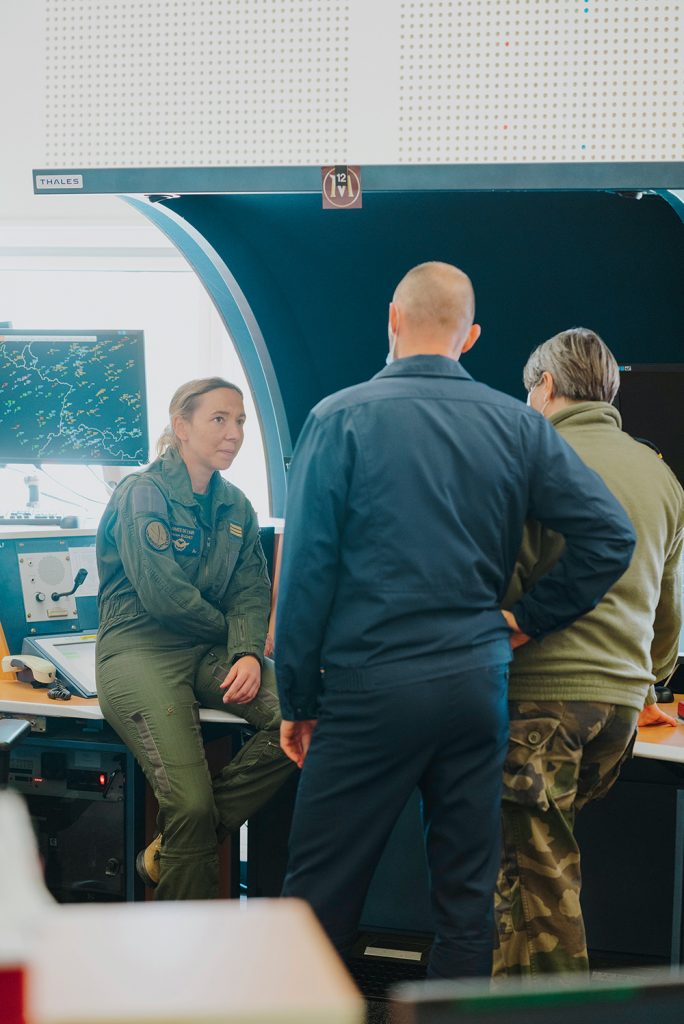24 hours with Marion Buchet (E.21)

With a diploma in psychology and a specialty in stress management, Marion Buchet is one of the rare female fighter pilots in the French armed forces. At age 38, the aviator is currently enrolled in the Trium EMBA program at HEC and is setting her sights on new horizons.
At the end of a long drive protected by concrete blocks and automatic gates, we’re stared at by many pairs of eyes. The military guards wait, dumbfounded, for us to explain just what a photographer armed with a Leica and a reporter with a pen and spiral notebook are doing here on this grey October morning. “Do you have an appointment?”, asks a voice from behind a protective glass panel. Welcome to air base number 705 in Tours! Yes, we have an appointment. And not with just anyone. Captain Marion Buchet, 38 years old, fighter pilot. In other words, a rare bird in the skies of the French air force.
9 AM, another world
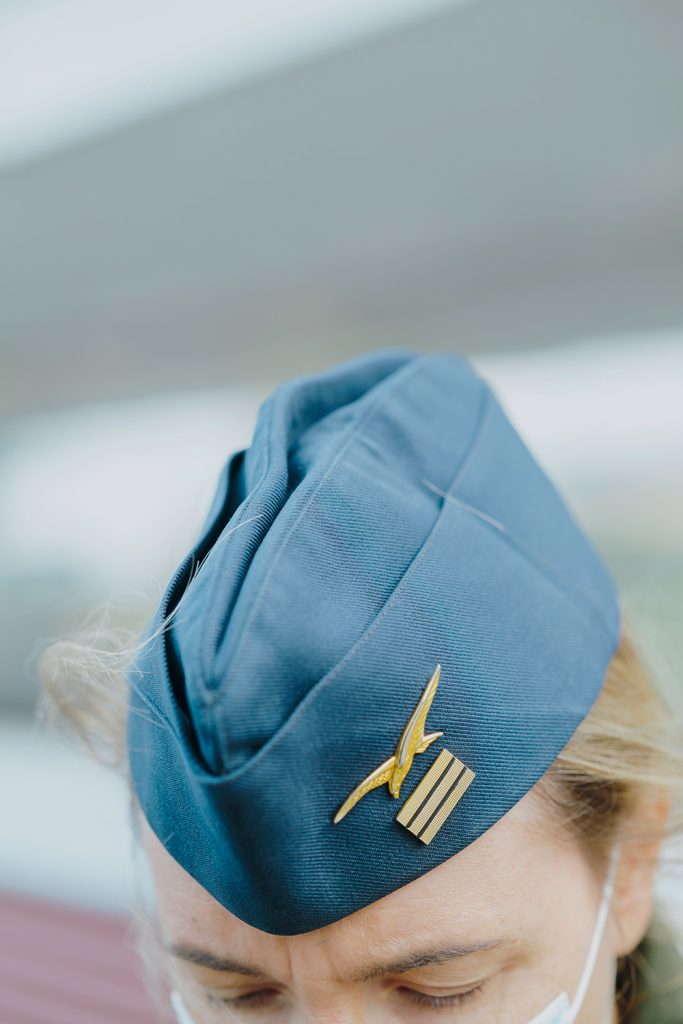
Marion Buchet has just returned from the Kuwaiti desert where she participated in an international mission, under a blazing sun and in temperatures that reached 51 °C. Here, in the mild climate of Tours, is where she’s based when she’s not deployed overseas (opex). After three months far from home, she has returned to her nine-year-old daughter Juliet and her normal life. “Back to my daily routine as a soldier and mother. Not much to say about that,” she explains, almost defensively,when we first reached her by phone and surprised her with an interview request. “We don’t spend all our time doing loops, you know,” she points out, in case we’re thinking of her landing like in a “Top Gun” remake. For one thing, this place doesn’t look at all like the California of the blockbuster. Not a single palm tree. And, instead of the Pacific, the meandering Loire.
The air base, spread out over 300 hectares, is filled with ruler-straight roads, buildings decked out in shades of greens and browns, and manicured lawns in the center of which the tricolor flag is flapping in the wind. Here and there, aging fuselages are displayed like works of art, their noses pointed to the sky. This enclave is well guarded. To enter it, you have to inform the base several days in advance that you are coming. Send in your date and place of birth so that they can be verified by the higher-ups. Don’t forget your passport. Once you’ve arrived, several formalities must be completed before you’re given the precious badge marked “visitor”. The whole process takes several minutes, during which it’s not a good idea to take even one photo. Finally, the gates open to this very orderly other world where Marion Buchet appears. Her gaze is steady, her hair is tucked into a military cap, and she’s wearing multipocketed khaki trousers and a matching aviator jacket, on which are displayed three gold bars, the insignia of her rank. There’s something a bit “Top Gun” about it after all, no doubt because of the aviator style, a subtle blend of confidence and ease.
9:30 AM; how to address her?
We hesitate… Should we say “My captain”, “My captainess”, “Madame captain”, or just “Captain”? “Just call me Marion, OK?” she laughs, with her hands in her pockets. The entry of women into the armed forces means that no one ever addresses officers or NCOs as “sir” if they are women. Most of the time, civilians are exempt from observing such protocols – especially in the air force, known for being a bit more relaxed. If you’re going to break the sound barrier, best not to be held back by conventions. “The tool we use in our work is the airplane; it has to be immediately effective,” Marion explains. “There’s a hierarchy, but it isn’t like we’re always thinking about ranks. We’re informal with each other most of the time.”
9:40 AM, time for her rounds
Now that she’s back from her mission, the aviator has returned to her usual tasks, in other words her Osab job, one of those mysterious army acronyms that designates “base air security officer”. “It means to oversee everything that has to do with air security,” she explains. This covers everything from directing firemen dealing with birds landing on the edge of the runway to making sure regulations are respected and maintaining equipment in good shape. A role that involves various divisions of this odd little military community. “This job means becoming an expert in all kinds of things. For example, I have had to learn how wild boars behave in order to protect our fences.” This morning, she makes her usual rounds. We pass closed-up hangars, workshops where maintenance is carried out, huge open spaces ready to welcome squadrons. We stop at the meteorological unit. Grey-shaded cumulus clouds and incomprehensible graphics move across big flat screens that two men in combat fatigues stare at fixedly. They nod briefly at us. On the wall, someone has displayed the motto of this silent little office. “Those who give up trying to be betterhave already stopped being good.” There’s the same sense of concentration 20 meters higher up, in the control tower overlooking the runway. The wide plate-glass windows reveal a 360-degree panorama. In the background, the forests of Touraine, verdant valleys and mists rising from the Loire. A panel displays in red the message “runway occupied”. A Falcon is set to land in a few hours. That’s all we know.
10 AM, a biological weapon
Back to solid ground. A sign on a door reads “ferret room”. Can we really ferret around in here? Marion smiles enigmatically. Inside, a big cage lined with straw is the home of Hermine, eight years old, a white-furred ferret with sharp teeth. The animal lives alone now, but until recently she presided over a fierce battalion of many of her kind. Their mission? “Flush out rodents and go after rabbits, even in their burrows, when they have the bad idea to colonize the edges of the runway,” explains the soldier in charge of this carnivorous squadron. “It’s an ancient hunting tactic, a bit savage, clearly, but one that works.” We can’t discuss the subject further, unfortunately, because the fire brigade is waiting for us next door.
-
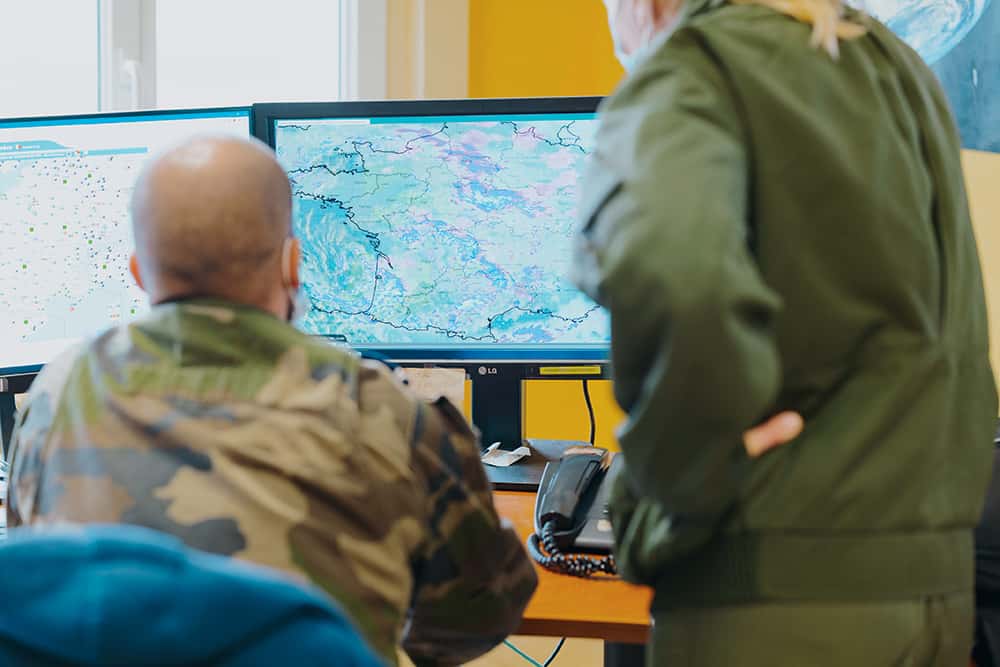
• Visit to the meteorological unit and the “watchtower”, the control tower overlooking the military base. -
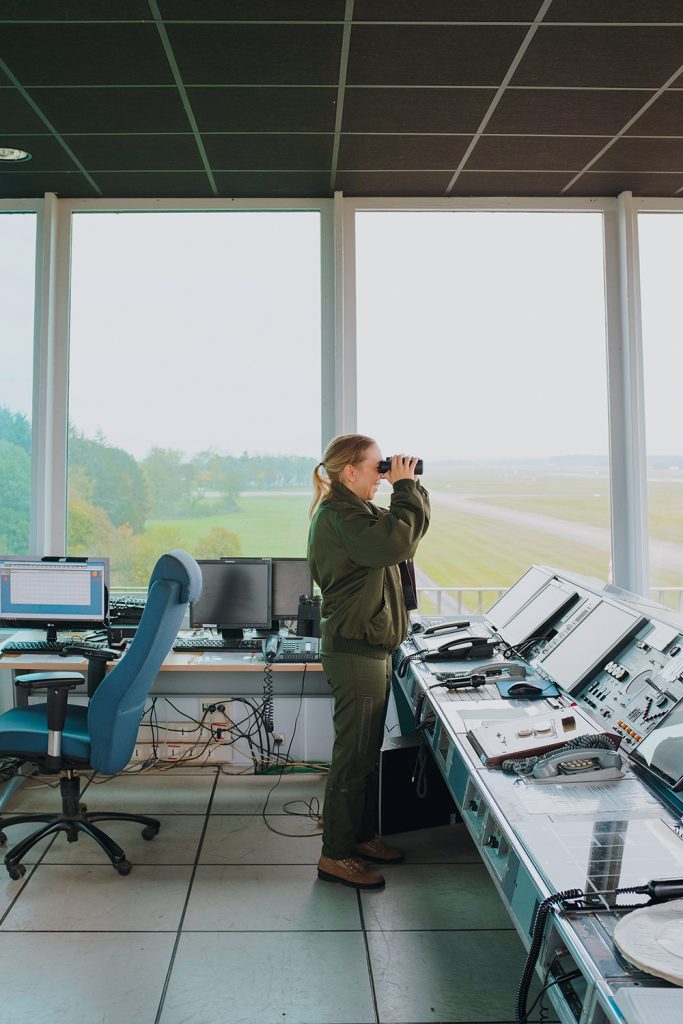
10:30 AM, toward the transition
Regulations dictate that any time a plane is taking off or landing, one of the base’s red fire trucks must be parked next to the runway, with its equipment ready to go. Today, the equipment is going to be checked out. It’s better to be sure that everything is working properly, especially since the base shares its main runway, around 2,400 meters long, with the little local civilian airport, Tours-Val de Loire. Before the covid crisis, personnel here dealt with up to 20 flights a day in high season. Most of them are Ryanair flights to Porto, Marrakech, Dublin or Marseille, but military flights also use the facilities. For the past 15 months, though, things have been a bit uncertain here. “You’re visiting in a big transition period,” Marion tells us. Base operations have been slowed down. Up until this past summer, Tours was the home of the prestigious French Armed Forces Fighter Pilot School, opened here in 1961. It has just moved to Cognac-Châteaubernard, in the Charente region. As for the fighter planes, there’s only one left in the hangars. The squadrons have moved with their pilots to air base 120, in Cazaux, Gironde. Next summer, the Tours facility and its aviation platform will be mainly turned over to the civilian aviation authority. Only air force personnel will continue to work here. The end of a world.
12 noon, in the mess
It’s impossible for Marion to hide her nostalgia. “On this base is where everything began for me, almost 20 years ago. My training, my first experiences on the simulator, and then my real flights. This will all soon be in the past. My last flight here was on June 5. A date that I will never forget.” At the officers’ mess, where we sit down with our tray, the aviator loosens up a little… first to recommend the delicious desserts in the commissioned officers’ cafeteria. She says the rice pudding and filled puff pastry reach stratospheric heights of gourmet deliciousness. And then she tells us about her career. “I wanted to be a doctor,” she says, “but after I passed my baccalaureate exam, I was invited to enter the air force school, and I accepted right away.” Why did she decide to become a pilot? “When I was 14 years old, I went on an initiation flight and they let me take the controls for a few minutes. I loved it and I continued to take classes with an instructor who was a former air-force pilot.” Life for this native of Toulouse will soon change in another way. “Retirement”, she says, with a mixture of sadness and self-mockery. Her contract is up at the end of next summer.
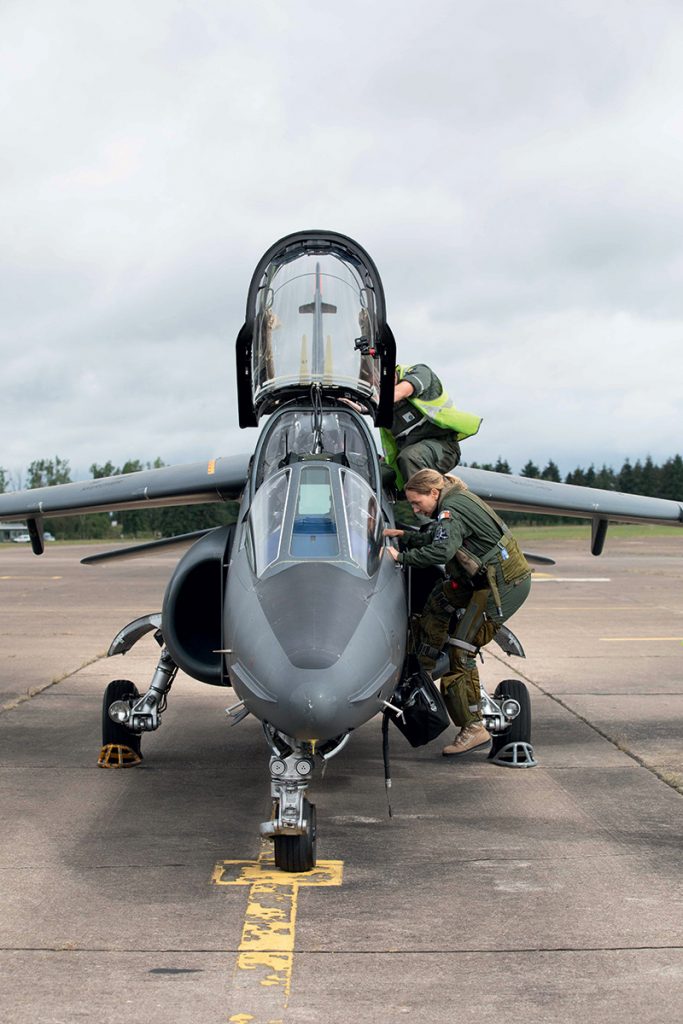
Years of training, missions in Africa and the Middle East, more than 2,500 hours of flight time in Alphajet, Mirage F1 and Mirage 2000 aircraft, multiple moves between bases in Tours, Reins and Nancy – all this will soon be in her past. “The hour has come to follow new paths, this time toward the business world,” Marion explains. A new direction that she has been planning for a long time. Along with her military career, she made sure to fill up her storage compartment with university baggage: legal training, then a masters in cognitive psychology. In all, 10 years of studies completed during her free time. And the Trium EMBA from HEC that she is currently completing. Her athleticism, her experience in managing emotions… These attributes equipped her to handle mental preparedness for the air force. Now, her profile interests recruiters, coaching teams and management schools. She has recently been asked to give conferences on decision-making, maintaining individual and collective performance, and stress management. Marion, who’s naturally a bit shy, is developing a taste for this. “What we call ‘soft skills’, having to do with behavior, fascinate me. Companies are also interested in this more and more, because often it’s such skills that make the difference in a team’s performance.” We already need to leave, to go to Cinq-Mars-la-Pile, just west of Tours. There’s a very important place there that Marion wants to show us.
2:30 PM, eyes on the sky
The next facility we’re visiting is affiliated with base 705 in Tours and is called the Military Center for Management and Control (CDC). “We are responsible for air security for the northwestern part of France,” our guide explains. Security is tight here. For example, we’re not allowed to mention the last names of the people we meet. We also have to leave our smartphones in a locker to make sure we don’t spy on anything. After passing through several security checkpoints, we reach the air-traffic-control center: a room equipped with dozens of radar screens, buzzing with radio communications. Teams here oversee France’s airspace around the clock to make sure there are no intrusions. One of the latest resounding actions by this unit resulted in a big “boom” heard in Paris last September 30. On that day, after radio contact with a plane headed for Saint Brieuc was lost, air-traffic controllers sounded an alarm, and a Rafale took off immediately. To reach the suspect aircraft as quickly as possible, the Rafale was authorized to fly at supersonic speed, hence the deafening “boom”. Looking at these screens, we think about Marion’s profession, the cool-headedness and mental preparation that it demands. Has she ever had to complete missions like this? Launch missiles, maybe? Another enigmatic smile. We will never know the answer.
4 PM, at the bottom of the mine
The tour continues under the escort of warrant-officer Alexandra, air-defense controller in charge of flight security. We descend into the bowels of the base on an interminable elevator ride. First, we have to spend a few minutes learning how to use an Oxy 3000 respiratory mask, a necessary piece of equipment in case of a fire on the underground floors. “You never know,” Marion points out as we look worried. A few more insulated hallways, plus security checkpoints worthy of James Bond, and here we are, 35 meters underground, in a hidden and heavily reinforced cellar connected to 18 kilometers of tunnels, where we reach another office in the shadows. In total silence, around 20 soldiers, their eyes glued to computer screens, oversee all the flight plans of any air force flights (and occasionally those of the navy, the army and the customs service). “55,000 flight plans per year”, says the head of the unit, Lieutenant Frédéric. On the wall, a world map, blinking lights, and … post cards sent by a few pilots who reached their destination! The clock displays GMT time. In this basement, the best-protected in France, it’s only 2 PM. The time we learn that the visit has lasted long enough.
5:30 PM, in the colonel’s office
Return to base 705. Marion heads to a gym session. “We’re required to stay in shape,” she says. Then, she puts her uniform back on before a meeting with the highest-ranking officer at the base, Colonel Guillaume Bourdeloux. This former fighter pilot wants to hear how things have been going since she returned from her latest mission. And also to get up to date on current projects. One of them in particular: setting up an e-signature system. This will eliminate excessive use of paper documents and paper clips. Committed to environmentally-friendly and efficient practices, the colonel assigned this mission to “the woman who can find a solution for anything”. “To be a soldier means being like a Swiss army knife,” she says. As a good soldier should, she doesn’t reveal how she feels about this war on administrative red tape. There’s no doubt; flying will get you anywhere.
Sébastien Desurmont
Published by La rédaction


